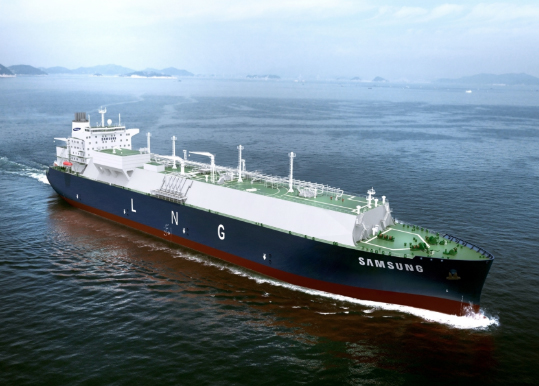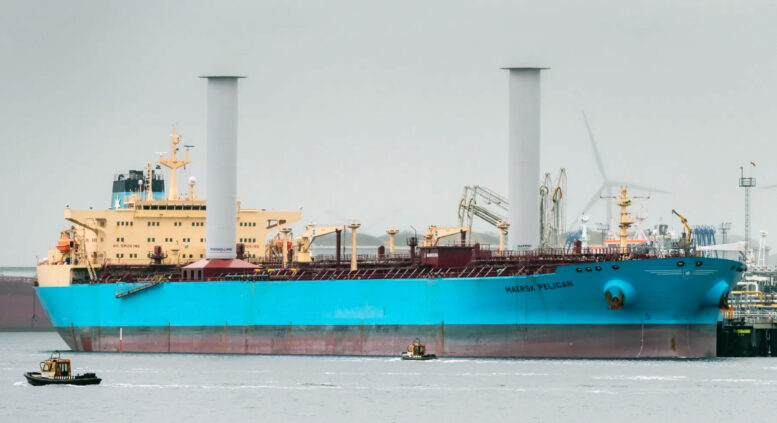As the shipping industry ramps up efforts to decarbonize, initial sea trials onboard a Maersk tanker fitted with Norsepower Rotor Sails indicate that wind power has the potential to play a significant role in a low carbon ocean transport system.
Early results from a sea trial onboard the 109,647 DWT Maersk Pelican fitted with two meters high, five meters in diameter Rotor Sails by Finnish sail technology provider, Norsepower, have proven an 8.2% reduction in fuel consumption is possible over a 12-month period.
The Norsepower Rotor Sails are large, cylindrical mechanical sails that operate based on the Magnus effect. Wind hits the spinning Rotor Sails, causing air to accelerate on one side of the Rotor Sail and decelerate on the other. The difference in the speed of airflow results in a direct pressure difference, creating a lifting force that is perpendicular to the wind flow direction. This generates a forward thrust, propelling the vessel.
Finding the right partner
In a webinar hosted by Blue Communications, Maersk’s Chief Technical Officer, Tommy Thomassen, revealed that the shipping company had explored many different energy saving devices and fuel saving technologies for some years, including various wind utilization technologies, but realized early on that Norsepower’s Flettner Rotor Sails rotors had the potential to yield significant power. “We scanned the market to see who was out there and the best provider for our tankers turned out to be Norsepower and that’s where the dialogue began,” Mr Thomassen said.
Preparing to fit the Rotor Sails
The Rotor Sails installed on the Maersk Pelican are, thus far, the largest to ever to be installed on a sea-going vessel. “We’re talking two 30-metre-high, five meter diameter Rotor Sails being installed on an existing ship in service,” Mr Thomassen confirmed. Prior to installation, Maersk carried out a thorough risk assessment, including an assessment of all the potential risky situations that Maersk could encounter and a consideration of all the operational performance parameters.
For Norsepower, this installation was the biggest scale up they had done, with the largest installation to date being an 18- meter sail. “For the first time we also fitted mechanical sails on a tanker ship, so we had to ensure it fitted the class requirements for an explosive environment,” said Tuomas Riski, CEO and partner at Norsepower.
“Norsepower received the initial contract from Maersk at the end of 2015 and from those early dialogues it took nearly two years to conclude the project but after that it went pretty fast. By August 2018, we had done the fitting; and by the end of 2019, we had the results of the trial,” noted Mr Riski.
“Shell came onboard as a consultant for the Energy Technologies Institute (ETI), a sponsor of one of the Rotor sails,” Stephen Brown, Technology Innovation and Decarbonization Manager at Shell confirmed.
“Lloyd’s Register was also brought on as a trusted expert. They performed the independent assessment of the performance of the Rotor Sails technology through measurement. Data systems were fitted to the Maersk Pelican and measurements were taken before and after to understand how performance differed,” Dr Chris Cradock, Technical Advisory and Ship Performance Manager at Lloyd’s Register explained.
Installing the Rotor Sails
Installation began on the Pelican while the vessel was carrying out an ordinary docking of the ship in China. In the first month, Norsepower installed the foundations, cabling and automation measure systems onboard and prepared the Rotor Sail units. The docking was in January 2018 and by August 2018, Norsepower had fitted the two Rotor Sails onboard.
Mr Thomassen said that one of the reasons they thought the technology was so interesting was because it was suited to retrofits. “The physical installation of the sails down in Rotterdam was almost the smallest piece of the work. It was a big event but not a big challenge.”
Mr Riski also confirmed that the installations were done without harming any of the coatings in the clean tanks.
It was also “a great learning curve” for all parties involved. The final installations of the Rotor Sails were done in less than 24 hours. “It takes a lot of preparation and planning but smooth and quick installations are possible,” said Mr Riski.

Norsepower’s Rotor Sails. Image courtesy of Norsepower.
Sea trials and performance measurement
Once the Rotor Sails were installed on the Pelican, it took less than a day to do the physical sea trial in Rotterdam, checking everything worked as it should and teaching the crew how to use the technology, Mr Thomassen from Maersk stated.
There many bold claims are made when it comes to energy saving technologies but it is vital to ensure that independent verification happens with such a technology as the Rotor Sails.
In terms of performance measurement, Dr Chris Cradock of Lloyd’s Register reiterated the importance of understanding the baseline performance of the vessel before sea trials began.
Measurement systems were installed onboard 6 months prior to the installation of the Rotor Sails. Once they were installed data was recorded for another 12 months to identify fuel consumption with and without the Rotor Sails each day.
While the results over that year indicated a fuel saving of 8.2% fuel, these were in align with Norsepower’s expected results of 7-10%.
Mr Riski said there was a “perfect harmony between the simulated model results and the Lloyd’s Register validation of the actual fuel savings achieved on the Pelican.”
Stephan Brown, Shell, reiterated the importance of achieving these results as part of a trial, and noted that naturally there were some teething problems that were overcome quickly.
However, the Maersk Pelican used for the trial was a ship already trading and according to Mr Brown, not always on the most favorable routes all of the time:
“The fact is that the wind speeds for that particular time of year for performance monitoring were lower than usual. The reality of this is that the 8.2% fuel savings were excellent.”
During the sea trial, the vessel sailed from the yard in the China to Far East Asia on transocean voyages.
Norsepower’s CEO said that based on the company’s simulation model, the same tanker sailing on a different route, from Rotterdam to New York for example, could result in a potential 20% cut in fuel.
During the 12 months, the Rotor Sails were utilized around 50 per cent of the time. According to Mr Riksi, simulation models show a payback based on typical tankers and long-term fuel prices of four to nine years.
Maersk’s chief technical officer said that it was also important to note that at present the low fuel prices make the ROI less attractive.
However, he noted that, “It is about far more than just fuel costs as it is hugely important to save CO2. We want to participate and drive the CO2 saving at the end and we believe this particular technology has huge potential and one of the biggest potentials for retrofits.”
One question asked during the webinar was whether the Rotor Sails could become less favorable on less windy routes. Maersk’s Mr Thomassen said that based on dialogue with different customers and the impact of trading routes, they haven’t seen any negative impact on the trading routes because of the Rotor Sails. The sails have also brought positive attention to the vessel, he confirmed.
Maintenance and operation
According to Norsepower, the Rotor Sails can be maintained with two checks per year, with the current estimation for maintaining the sails at one-man day per 6 months. Mr Riski said that these checks are simple and can be done by the crew. Norsepower will also deliver the spare parts if needed.
Mr Thomassen echoed these words and confirmed that the sails are, “pretty simple to operate and pretty simple to maintain, which is also part of the attractiveness of this particular technology.”
Wind power and decarbonizsation
The role of wind power in decarbonizing shipping is yet to be fully understood, however Dr Chris Cradock from Lloyd’s Register is confident that these Rotor Sails will play a large role in the industry’s efforts in making a zero carbon transport system alongside other energy saving devices.
“There won’t be one single device that is a full solution to solve the decarbonization problems we have but this technology as have many others have demonstrated that they will be part of the solution.”
“Most energy saving devices we see onboard ships today are in the realm of 1-3% fuel savings but when you start getting over 5 per cent it becomes a really interesting technology. Because it has such a high benefit it will probably play a strong part going into the future of decarbonization.”
“We still need to look at alternative fuels as well as reducing the powering requirement of these ships and Flettner Rotors is a solution to do that as well. It will be a collection of different technologies that will solve the decarbonization problem,” Dr Cradock clarified.
Source: https://vpoglobal.com/2020/06/28/sailing-on-sustainability-the-comeback-of-wind-power/
